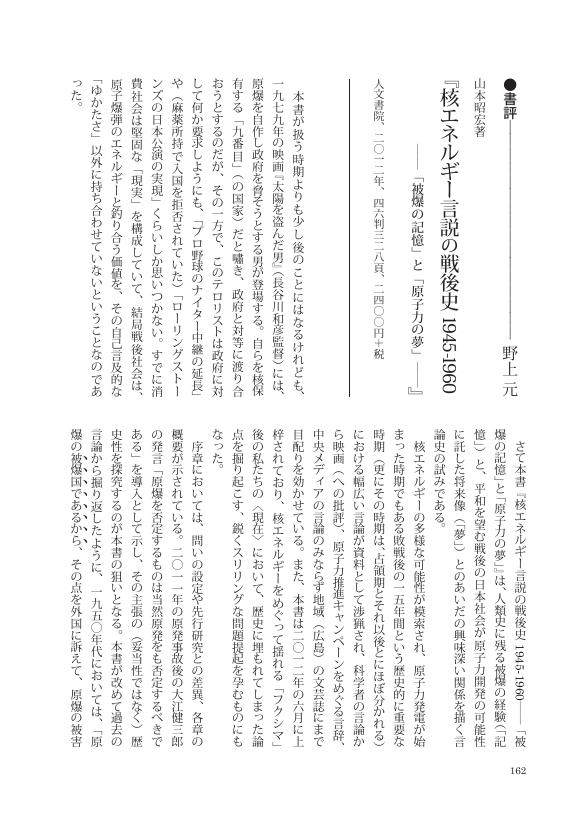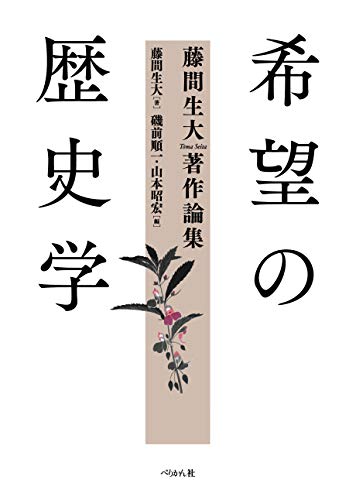32 0 0 0 現代の戦争研究と総力戦研究とを架橋する学際的戦争社会学研究領域の構築
2018年度は、5年間の研究計画の二年目であった。まず、4月14、15日に東京大学で行われた戦争社会学研究会第9回大会の場を利用して、野上は、東京大学文学部社会学教授・佐藤健二氏を招いて特別講演「「戦争と/の社会学」のために」を企画した。これもまた、学際的研究領域としての「戦争社会学」の内実を検討するものであり、活発な質疑を経て、戦争社会学の可能性を検討することができた。また西村は、テーマセッション「宗教からみる戦争」を企画した。宗教と戦争と社会の結びつきについて、多面的な議論が行われた。6月には、同研究会の研究誌『戦争社会学研究』の第二号が刊行された。特集となる「戦争映画の社会学」は、昨年度企画したシンポジウム「『野火』の戦争社会学」の活字化である。企画者の山本ほか、野上・福間が寄稿した。また、第二特集として「旧戦地に残されたもの」があり、西村が企画趣旨文を寄せている。8月12日には、京都女子大学で小林啓治『総力戦の正体』の書評会を開催した。歴史学の立場からの「戦争と社会」研究であるが分野をまたいだ議論を可能にする幅広い問題提起を行う書物であった。書評担当者の一人を野上が担ったが、「戦争と社会」研究における「総力戦」概念の重要性に照らした検討を行った。この2018年度より、筑波大学を所属機関とする非常勤研究員として木村豊氏を雇用し、研究会の事務手続きを手伝ってもらうことになった。こうした研究会の企画のほか、研究打ち合わせを12月に行い、プレ調査の実施計画を進め、科研メンバーだけのクローズドな研究会を行った。また、筑波大学大学院「歴史社会学」演習と合同で、深谷直弘『原爆を継承する実践』の書評会を筑波大学で行った。若手研究者による戦争社会学的研究の成果である。
- 著者
- 山本 昭宏
- 出版者
- 日本マス・コミュニケーション学会
- 雑誌
- マス・コミュニケーション研究 (ISSN:13411306)
- 巻号頁・発行日
- vol.79, pp.153-170, 2011
This paper analyzes articles about nuclear energy in three science magazines, Kagaku Asahi (Asahi Science), Shizen (Nature), and Kagaku (Science), which were published in Japan in the 1950s. The analytical methodology used in the study is a combination of quantitative analysis and theory concerned with the agenda-setting function of the media. The study aims to reveal the relationship between the discourse found in the articles and Japanese opinions concerning nuclear energy development and radioactive substances, and to explore the qualitative changes in the discourse of the articles and the reasons underlying such changes. One conclusion that emerges from the quantitative analysis is that the number of discourses concerning nuclear energy increased between 1954 and 1955, and following this started to steadily decrease. Generally speaking, the Lucky Dragon 5 incident in 1954, in which the crew of a Japanese fishing vessel was exposed to nuclear fallout from US nuclear testing on Bikini Atoll, is considered to have started the anti-nuclear movement in Japan. At this time, in the science magazines, there was an increase in specialist discourses concerning topics such as nuclear reactors and methods of measuring nuclear fallout. In reality, almost all the scientists involved in nuclear energy research and development thought that they had no connection to the anti-nuclear movement. Based on a purely dualistic conception of good and bad, they continued to position nuclear energy as something to be used for good. From this perspective, it can be seen that in the Japanese science magazines of the 1950s, the nuclear bombing of Hiroshima and Nagasaki and its effects were understood only in a very limited sense.
6 0 0 0 OA 「原子力の夢」と新聞 : 1945~1965年における『朝日新聞』『読売新聞』の原子力報道に関する一考察(<特集>メディアは原子力とどう向き合ってきたのか-原子力・原発報道の史相を探る-)
- 著者
- 山本 昭宏
- 出版者
- 日本メディア学会
- 雑誌
- マス・コミュニケーション研究 (ISSN:13411306)
- 巻号頁・発行日
- vol.84, pp.9-27, 2014-01-31 (Released:2017-10-06)
- 参考文献数
- 20
The purpose of this paper is to propose a hypothesis about the process through which the media builds up collective expectations concerning nuclear power (the Nuclear Dream) and the transformation of such expectations. We focus on the Asahi and Yomiuri Newspapers and study not only editorials, but also regular features that are likely to have affected public opinion as much as editorials. The period targeted in this paper is the 20 years from 1945 to 1965. We divide these 20 years into three periods based on changes in the Nuclear Dream: the dream of war deterrence (1945 to 1949) ; the dream of peaceful use (1949 to 1957) ; and the dream of nuclear power generation (1957 to 1965). Japanese newspapers were unknowingly trapped in the Nuclear Dream that they built up through their own discourse; while they detached themselves from the Nuclear Dream in the late 1950s, they expanded the dream again in the 1960s. By describing this process, we examine how it is possible to meet collective expectations built up by the media.
5 0 0 0 IR 「火垂るの墓」のメディア文化論 (小浜善信・長江裕芳・村本詔司教授記念号)
- 著者
- 山本 昭宏
- 出版者
- 神戸市外国語大学研究会
- 雑誌
- 神戸外大論叢 = The Kobe City University journal = The Kobe Gaidai ronso (ISSN:02897954)
- 巻号頁・発行日
- vol.64, no.3, pp.69-86, 2014-03
2 0 0 0 OA 「火垂るの墓」のメディア文化論
- 著者
- 山本 昭宏
- 出版者
- 神戸市外国語大学研究会
- 雑誌
- 神戸外大論叢 = Journal of foreign studies (ISSN:02897954)
- 巻号頁・発行日
- vol.64, no.3, pp.69-86, 2014-03-01
1 0 0 0 人権と差別をめぐる比較宗教史
- 著者
- 磯前 順一 小倉 慈司 苅田 真司 吉田 一彦 鍾 以江 Pradhan Gouranga 久保田 浩 山本 昭宏 寺戸 淳子 岩谷 彩子 小田 龍哉 藤本 憲正 上村 静
- 出版者
- 国際日本文化研究センター
- 雑誌
- 基盤研究(A)
- 巻号頁・発行日
- 2019-04-01
西洋近代に由来する人権思想の世界的な普及にもかかわらず、当の西洋においても、あるいは日本などの他のさまざまな地域においても、差別(人種差別だけでなく、いじめや戦争、 テロまでを含む)が依然としてなくならないのは、なぜだろうか。本研究では、これまで「聖なるもの」と「俗なるもの」の二分法で説明されてきた「宗教」と「社会」とのありかたの理解を、日本宗教史と世界諸地域の比較宗教史との学問の蓄積からあらたに問いなおし、現代社会における公共性の問題と結びつけて検討する。そのことで、公共空間における差別と聖化の仕組みがあきらかになり、より具体的な公共性のあり方についての議論が可能になることが期待される。
- 著者
- 山本 昭宏
- 出版者
- 日本マス・コミュニケーション学会
- 雑誌
- マス・コミュニケーション研究 (ISSN:13411306)
- 巻号頁・発行日
- vol.79, pp.153-170, 2011-07-31 (Released:2017-10-06)
- 参考文献数
- 7
This paper analyzes articles about nuclear energy in three science magazines, Kagaku Asahi (Asahi Science), Shizen (Nature), and Kagaku (Science), which were published in Japan in the 1950s. The analytical methodology used in the study is a combination of quantitative analysis and theory concerned with the agenda-setting function of the media. The study aims to reveal the relationship between the discourse found in the articles and Japanese opinions concerning nuclear energy development and radioactive substances, and to explore the qualitative changes in the discourse of the articles and the reasons underlying such changes. One conclusion that emerges from the quantitative analysis is that the number of discourses concerning nuclear energy increased between 1954 and 1955, and following this started to steadily decrease. Generally speaking, the Lucky Dragon 5 incident in 1954, in which the crew of a Japanese fishing vessel was exposed to nuclear fallout from US nuclear testing on Bikini Atoll, is considered to have started the anti-nuclear movement in Japan. At this time, in the science magazines, there was an increase in specialist discourses concerning topics such as nuclear reactors and methods of measuring nuclear fallout. In reality, almost all the scientists involved in nuclear energy research and development thought that they had no connection to the anti-nuclear movement. Based on a purely dualistic conception of good and bad, they continued to position nuclear energy as something to be used for good. From this perspective, it can be seen that in the Japanese science magazines of the 1950s, the nuclear bombing of Hiroshima and Nagasaki and its effects were understood only in a very limited sense.
- 著者
- 山本 昭宏
- 出版者
- 大阪歴史学会
- 雑誌
- ヒストリア = Historia : journal of Osaka Historical Association (ISSN:04392787)
- 巻号頁・発行日
- no.279, pp.79-84, 2020-04
1 0 0 0 希望の歴史学 : 藤間生大著作論集
- 著者
- 藤間生大著 磯前順一 山本昭宏編
- 出版者
- ぺりかん社
- 巻号頁・発行日
- 2018
- 著者
- 山本 昭宏
- 出版者
- 立命館大学国際言語文化研究所
- 雑誌
- 立命館言語文化研究 (ISSN:09157816)
- 巻号頁・発行日
- vol.28, no.3, pp.7-16, 2017-01
1 0 0 0 OA 「原子力の夢」と新聞 : 1945〜1965年における『朝日新聞』『読売新聞』の原子力報道に関する一考察(<特集>メディアは原子力とどう向き合ってきたのか-原子力・原発報道の史相を探る-)
- 著者
- 山本 昭宏
- 出版者
- 日本マス・コミュニケーション学会
- 雑誌
- マス・コミュニケーション研究 (ISSN:13411306)
- 巻号頁・発行日
- no.84, pp.9-27, 2014-01-31
The purpose of this paper is to propose a hypothesis about the process through which the media builds up collective expectations concerning nuclear power (the Nuclear Dream) and the transformation of such expectations. We focus on the Asahi and Yomiuri Newspapers and study not only editorials, but also regular features that are likely to have affected public opinion as much as editorials. The period targeted in this paper is the 20 years from 1945 to 1965. We divide these 20 years into three periods based on changes in the Nuclear Dream: the dream of war deterrence (1945 to 1949) ; the dream of peaceful use (1949 to 1957) ; and the dream of nuclear power generation (1957 to 1965). Japanese newspapers were unknowingly trapped in the Nuclear Dream that they built up through their own discourse; while they detached themselves from the Nuclear Dream in the late 1950s, they expanded the dream again in the 1960s. By describing this process, we examine how it is possible to meet collective expectations built up by the media.

